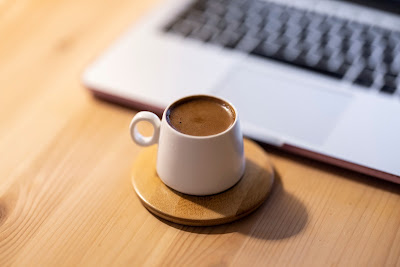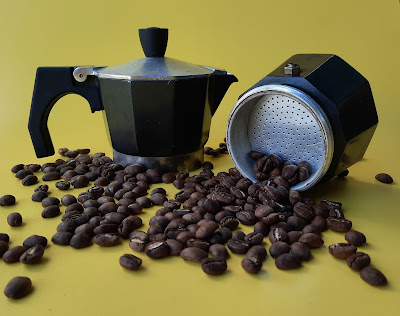Whether it comes from one of the top
espresso machines or another means, a shot or two of espresso will give you a
good caffeine boost. It has a more strong flavour and body than your typical
cup from the finest drip coffee machine, whether you're adding it to a morning
latte or drinking a solo shot in the afternoon.
Espresso is a brew technique of
preparing coffee, according to Cary Wong, a coffee expert with Partners Coffee.
It employs highly pressurised water to push the coffee to extract fast, which
makes it distinct from other types of brewed coffee, the man claims. Then, that
extracted espresso provides the perfect foundation for to brew coffee beverages
with milk or to consume on its own.
How to use an espresso maker to create espresso
·
Prepare the device. Check the water reservoir
after turning on the espresso maker and wait for it to warm up. Before brewing
new espresso, clean the portafilter to make sure there are no lingering grounds
in the basket.
·
Add freshly ground coffee to the cup. Add
freshly ground coffee to the portafilter's basket. Pack the grinds into a puck
using the tamper.
·
Portafilter attached. Attach the portafilter
to the espresso machine's group head by twisting and locking it.
·
Pull the trigger. The espresso maker's start
button or knob can be used to turn on the pump. By doing so, hot water will be
forced into the cup through the coffee grinds.
·
Consume the espresso. Drink the espresso right
away.
Making coffee without a machine
While an espresso machine will produce the perfect espresso shot,
there are a few additional techniques that can deliver results that are
comparable. The following techniques may be used to obtain strong coffee
concentrate that will behave similarly in beverages, despite what purists would
tell you.
Moka Pots
Moka pots are our preferred substitute for espresso machines. One
to two bars of pressure are produced by stovetop espresso machines, like our
top selection, the Grosche Milano, to brew coffee that is similar to espresso.
Use cold water to fill your Moka pot's bottom to just below the
purge valve before starting to brew. Instead of being tamped, the grounds
should be gently levelled before being placed in the basket. Use grinds that
fall somewhere between drip coffee (medium-coarse) and espresso (extremely
fine).
On a hob or over a campfire, you can brew. Place your Moka with
the lid open over a medium-low heat. Wait until the coffee starts to come out
of the spout or reaches 158–167 degrees Fahrenheit before inserting a meat
thermometer into the hole in the spout. Finally, take the pot from the bonfire
or turn off the heat and let it steep until it stops.
The French Press
Wong claims that while a French press couldn't provide the same
texture as an espresso machine, it may still produce some of the same
concentrated coffee oils and aromatics.
To begin, grind an espresso roast to coarsely fine grounds using
one of the finest coffee grinders. After that, boil one cup of water for every
two teaspoons of coffee grinds. Pour barely enough hot water into the French
press to cover the grounds after combining the two.
Allowing the coffee to bloom and the concentrated flavour
extraction to start requires letting the coffee and water sit for a little
period of time. After that, add the remaining water and wait four minutes.
Slowly and gently depress the plunger of the French press after four minutes.
After being plunged, the coffee will be black, intense, and similar to
espresso.
AeroPress
An espresso produced with an espresso machine is somewhat more
similar to that made with an AeroPress. A very concentrated cup of coffee can
be made using an AeroPress, but it won't have the lovely crema and body that
professional and domestic espresso machines make, according to Wong.
Start by finely grinding an espresso roast and boiling the water
(one cup for every two tablespoons of grounds), just as you would with a French
press. After rinsing, set the AeroPress filter down. Place the press on top of
a solid mug and secure the drain cap. Pour the grounds into the AeroPress and
tamp them down using a cylindrical device like a muddler. then add the boiling
water after that. After mixing the two, wait 30 seconds.
Serving recommendations
There are other methods to enjoy espresso outside the common practice
of sipping it alone.
Americano: Add the
same quantity of hot water as espresso to soften the strong flavor.
Affogato: For an energizing
sweet treat, place a scoop of vanilla ice cream or gelato in a small dish or
cup and top with hot espresso.
Espresso is best when combined with equal parts steamed milk and
frothed milk on top for a cappuccino, a creamy coffee beverage. Although a cappuccino isn't normally flavoured,
cinnamon or cocoa powder can be added as a garnish.
Espresso with
panna: Add some whipped cream to your espresso for a touch of
sweetness. Make your own whipped cream at home or use a high-quality brand.
When in doubt, simply pour some chocolate syrup into a cup for a mocha. Pour heated milk on top, add
espresso on top, and mix for a sweeter, caffeinated beverage.
Insider's conclusion
Whether consumed alone or as part of a coffee beverage, a shot or
two of espresso is a common choice. And while buying espresso at your
neighbourhood coffee shop is widespread, it may also be produced at home. True
espresso is best made with an espresso machine, but you can still get a
similarly concentrated flavour at home using alternatives like a French press
or an AeroPress.







.png)


0 Comments